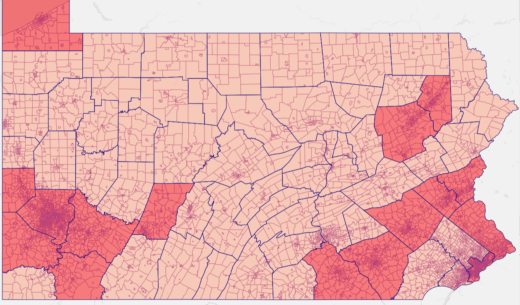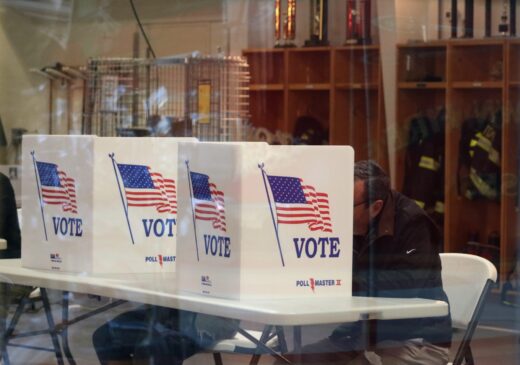By Nick Field | Pennsylvania Capital-Star
Four years ago, the prospect of a competitive Presidential primary led to some relatively strong voter registration reports for Pennsylvania’s Democratic Party. Yet as 2020 progressed that contested primary never came, and the summer and fall registration reports were far more encouraging for the Pennsylvania GOP. Nevertheless, Biden was ultimately able to win back the Keystone State in November.
So Pennsylvania Democrats can take just a bit of solace in the fact that these latest voter registration trends can only tell us so much about future election results.
But that doesn’t mean we just should ignore the overwhelming nature of these numbers. Since I first started tracking voter registrations trends in Pennsylvania, Republicans have generally eaten into Democrats’ historic advantage. This is the first time I can recall, however, that the GOP posted gains in all 67 counties throughout the commonwealth.
Furthermore, the comparison to the last Presidential cycle is particularly stark. Back during the COVID-delayed voter registration deadline in May 2020, the Democratic advantage was D+803,427. Today it stands at 397,241. In that time 122,639 more voters have joined the rolls, yet Dems have lost 195,867 registrants as the Republicans gained 210,319. All the while, independent voters who chose either no affiliation or some other party rose 108,187.

Even the shift since last October is significant. Back then, the Democratic advantage was 445,890. Over this period, Democrats lost 4,560 registrants, while Republicans gained 44,089 and Independents added 26,233. Therefore, let’s dive into the regional breakdowns in order to dig deeper into this movement.
A quick note: I explore our changing voter trends by tracking the gains one party accumulated in registrations over the other party. For example, R+500 means that the Republican Party gained a net 500 more registered voters in that county than the Democratic Party did over this period, while D+500 indicates the opposite.
Central
- Blair: R+577
- Bradford: R+408
- Cameron: R+19
- Centre: R+286
- Clearfield: R+523
- Clinton: R+308
- Columbia: R+411
- Elk: R+244
- Huntingdon: R+218
- Juniata: R+126
- Lycoming: R+396
- McKean: R+185
- Mifflin: R+117
- Montour: R+112
- Northumberland: R+438
- Potter: R+134
- Snyder: R+168
- Sullivan: R+4
- Tioga: R+251
- Union: R+147
Traditionally, the Democratic Party picks up new voters in Centre County thanks to Penn State University enrollment. On top of that, more recently, Bucknell University has driven Dem improvement in Union County as well. Not this time, though, as new Republican registrations outpaced the opposition.
Northeast
- Carbon: R+417
- Lackawanna: R+1,258
- Luzerne: R+2,221
- Monroe: R+756
- Pike: R+337
- Schuylkill: R+919
- Susquehanna: R+210
- Wayne: R+232
- Wyoming: R+156
Ever since the bottom practically fell out for Hillary Clinton in Lackawanna and Luzerne Counties, I’ve kept a close eye on the Northeast. Luzerne, home to Wilkes-Barre, has been trending red for awhile now – though Josh Shapiro’s still been able to win here – and it now appears possible that Republicans registrants will pass Democrats here before November.
Despite such setbacks, Lackawanna will remain a Dem plurality county, and hometown boy Joe Biden will need to put together a strong performance here to hold onto Pennsylvania’s 19 electoral votes.
Northwest
- Clarion: R+272
- Crawford: R+370
- Erie: R+1,354
- Forest: R+42
- Jefferson: R+213
- Mercer: R+751
- Venango: R+266
- Warren: R+299
Despite being on opposite ends of the commonwealth, Erie and Lackawanna Counties have much in common. They’re both long-time working-class Democratic counties where Republicans are picking up support, and Biden likely needs to improve his performance in both of them.
Yet unlike Lackawanna, the lakeside county saw Democratic gains in the early months of 2021, when Dems experienced a bit of post-January 6th bounce. Perhaps this indicates that the Biden campaign’s democracy message will resonate here.
South Central
- Adams: R+553
- Bedford: R+310
- Cumberland: R+457
- Dauphin: R+578
- Franklin: R+697
- Fulton: R+144
- Lancaster: R+1,507
- Lebanon: R+461
- Perry: R+256
- York: R+2,283
I like to call South Central ‘The Big Red Machine’ of Pennsylvania, as Lancaster and York are traditionally the most populous red counties in the commonwealth. Recently, however, Democrats have experienced some growth here, leaving Westmoreland as the favorite to one day take the GOP’s Red Crown. It turns out, however, that York County isn’t ready to hand over that title just yet.
Meanwhile, Republicans managed to gain even in Dauphin and Cumberland, which thanks to Harrisburg and its surrounding suburbs, is one of Pennsylvania’s top Dem-trending areas. Nonetheless, there was no room for a blue oasis this time.
Southeast
- Berks: R+1,862
- Bucks: R+2,414
- Chester: R+681
- Delaware: R+187
- Lehigh: R+1,506
- Montgomery: R+988
- Northampton: R+1,328
- Philadelphia: R+3,548
This Bucks number is the most eye-popping of all. Back in May 2020, Democrats held a 15,552 registration advantage here, yet now it’s down to a precarious 1,710. It seems that while the white-collar voters in Central Bucks abandoned the GOP in the Trump years, the blue-collar voters in Lower Bucks are only now leaving their ancestral Democratic home.
As for the rest of SEPA, there’s a reason Biden’s visited Philadelphia more than any other city besides Wilmington: he knows how pivotal the collar counties were to his victory in 2020. Biden improved on Hillary’s margin here by nearly 105,000 votes, enough to flip the commonwealth on its own. Therefore, more than anywhere else, it’s critical that Democrats retake the initiative here over the rest of this year.
Southwest
- Allegheny: R+2,916
- Armstrong: R+447
- Beaver: R+1,264
- Butler: R+970
- Cambria: R+1,072
- Fayette: R+1,198
- Greene: R+236
- Indiana: R+470
- Lawrence: R+703
- Somerset: R+448
- Washington: R+1,483
- Westmoreland: R+2,537
Since my last update back in October, Beaver County has gone from Democratic-plurality to Republican-plurality, making it the last of the non-Allegheny Southwest counties to make the switch. By this point, the ancestral Appalachian Democrats are all but extinct.
The question now becomes how many more votes from this region Trump could possibly bank. After all, Trump improved in many of these counties in 2020, yet it wasn’t enough to offset his losses in the other parts of the state. This all speaks to our overall conundrum: are these numbers lagging indicators of past movement or an indication of the future?
Voter registrations have now nearly caught up to actual voting. In 66 of PA’s 67 counties, the party with the most registrants is the same party that won that county in the 2020 Presidential contest. Luzerne is the only outlier, with Democrats holding onto to a 2,746 margin, which at this pace will likely be gone by the October general election deadline.
So while winning toss-up swing counties like Erie and Northampton will remain important, the margins in the Southeast and Southwest counties are bound to be the decisive factor in November.
In recent statewide races, Democratic candidates like Tom Wolf, John Fetterman and especially Josh Shapiro have racked up enormous advantages in Philadelphia and its surrounding suburbs. Can Biden match those margins or will Trump inspire low-propensity voters to turn out?
Similarly in the Southwest, has Trump hit his ceiling out there or can he find even more support?
Furthermore, there’s the growing number of Independents. I know I’ve been guilty of binary thinking (that is kind of the idea of this whole series). Today, though, a significant portion of Democratic and Republican voters prefer not to classify themselves that way. Which way will these voters break, and more crucially, by how large a margin?
Finally, while the 2020 contest saw record turnout, enthusiasm is much more muted this time around, and we don’t really know who will benefit from such a scenario.
All the more reason to examine every piece of information we can before Election Day, even if there’s only so much we can glean before the votes are actually cast.
Pennsylvania Capital-Star is part of States Newsroom, a network of news bureaus supported by grants and a coalition of donors as a 501c(3) public charity. Pennsylvania Capital-Star maintains editorial independence. Contact Editor Kim Lyons for questions: info@penncapital-star.com. Follow Pennsylvania Capital-Star on Facebook and Twitter.








